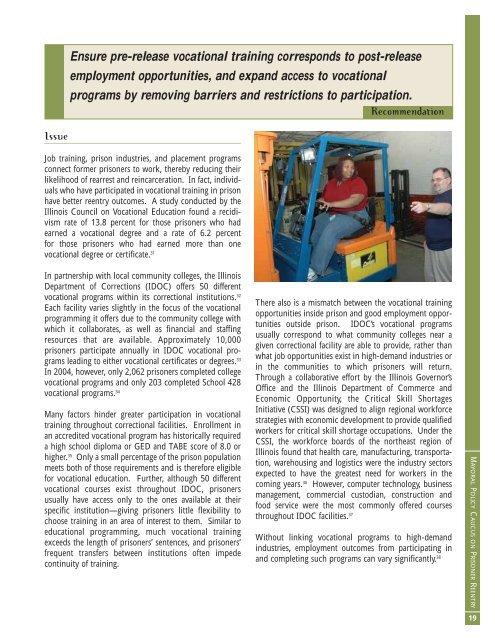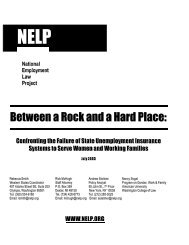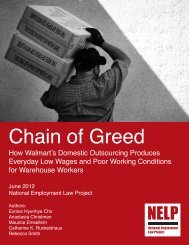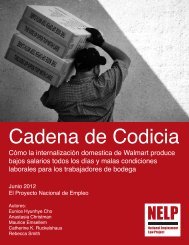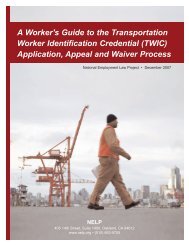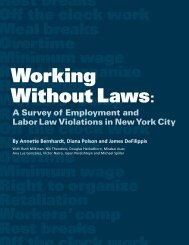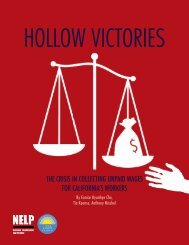Rebuilding Lives. Strengthening Communities.
Rebuilding Lives. Strengthening Communities.
Rebuilding Lives. Strengthening Communities.
You also want an ePaper? Increase the reach of your titles
YUMPU automatically turns print PDFs into web optimized ePapers that Google loves.
Ensure pre-release vocational training corresponds to post-release<br />
employment opportunities, and expand access to vocational<br />
programs by removing barriers and restrictions to participation.<br />
Recommendation<br />
Issue<br />
Job training, prison industries, and placement programs<br />
connect former prisoners to work, thereby reducing their<br />
likelihood of rearrest and reincarceration. In fact, individuals<br />
who have participated in vocational training in prison<br />
have better reentry outcomes. A study conducted by the<br />
Illinois Council on Vocational Education found a recidivism<br />
rate of 13.8 percent for those prisoners who had<br />
earned a vocational degree and a rate of 6.2 percent<br />
for those prisoners who had earned more than one<br />
vocational degree or certificate. 31<br />
In partnership with local community colleges, the Illinois<br />
Department of Corrections (IDOC) offers 50 different<br />
vocational programs within its correctional institutions. 32<br />
Each facility varies slightly in the focus of the vocational<br />
programming it offers due to the community college with<br />
which it collaborates, as well as financial and staffing<br />
resources that are available. Approximately 10,000<br />
prisoners participate annually in IDOC vocational programs<br />
leading to either vocational certificates or degrees. 33<br />
In 2004, however, only 2,062 prisoners completed college<br />
vocational programs and only 203 completed School 428<br />
vocational programs. 34<br />
Many factors hinder greater participation in vocational<br />
training throughout correctional facilities. Enrollment in<br />
an accredited vocational program has historically required<br />
a high school diploma or GED and TABE score of 8.0 or<br />
higher. 35 Only a small percentage of the prison population<br />
meets both of those requirements and is therefore eligible<br />
for vocational education. Further, although 50 different<br />
vocational courses exist throughout IDOC, prisoners<br />
usually have access only to the ones available at their<br />
specific institution—giving prisoners little flexibility to<br />
choose training in an area of interest to them. Similar to<br />
educational programming, much vocational training<br />
exceeds the length of prisoners’ sentences, and prisoners’<br />
frequent transfers between institutions often impede<br />
continuity of training.<br />
There also is a mismatch between the vocational training<br />
opportunities inside prison and good employment opportunities<br />
outside prison. IDOC’s vocational programs<br />
usually correspond to what community colleges near a<br />
given correctional facility are able to provide, rather than<br />
what job opportunities exist in high-demand industries or<br />
in the communities to which prisoners will return.<br />
Through a collaborative effort by the Illinois Governor’s<br />
Office and the Illinois Department of Commerce and<br />
Economic Opportunity, the Critical Skill Shortages<br />
Initiative (CSSI) was designed to align regional workforce<br />
strategies with economic development to provide qualified<br />
workers for critical skill shortage occupations. Under the<br />
CSSI, the workforce boards of the northeast region of<br />
Illinois found that health care, manufacturing, transportation,<br />
warehousing and logistics were the industry sectors<br />
expected to have the greatest need for workers in the<br />
coming years. 36 However, computer technology, business<br />
management, commercial custodian, construction and<br />
food service were the most commonly offered courses<br />
throughout IDOC facilities. 37<br />
Without linking vocational programs to high-demand<br />
industries, employment outcomes from participating in<br />
and completing such programs can vary significantly. 38<br />
MAYORAL POLICY CAUCUS ON PRISONER REENTRY<br />
19


